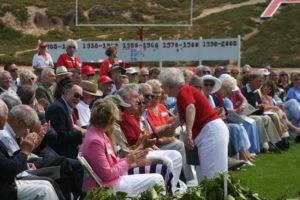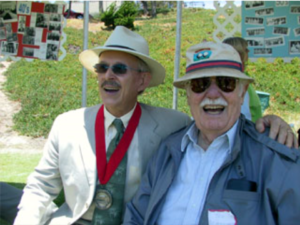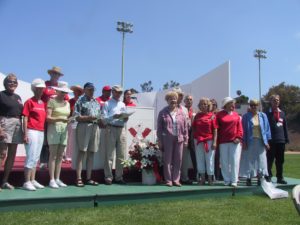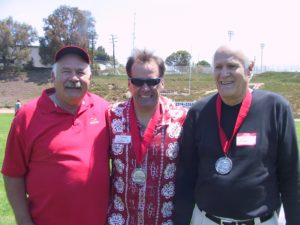Centennial stories
by Mark McDermott STAFF WRITER – THURSDAY July 2, 2005, REPRINT BY PERMISSION EASY READER
Every spring, a new crop of fresh-faced graduates joins the ranks of Redondo Union High School alumni. Each year at commencement ceremonies, speakers exhort the latest batch of Sea Hawks to go forth into the world and bring their talents, hopes, and dreams to fruition.
Since its founding in 1905 as a two-room schoolhouse, RUHS has graduated nearly 28,000 students. On June 25, nearly 1,000 of those students came back for a celebration marking the school’s centennial. The event brought together students from the last seven decades in what amounted to the reverse of a commencement: rather than marking their entry into the world, the Sea Hawk Centennial saw the school welcoming alumni home.
What those students have done in the world is astonishing in its range of accomplishments.
A ceremony at the Centennial celebration honored those voted by other alumni as the 100 most distinguished graduates. Among those honored were professors and professional athletes; a businessman who founded the “9 Lives” cat food empire by discovering that felines love red-meat tuna and a scientist whose discoveries of black holes and gamma rays have altered our understanding of the universe; a woman who has sung for the Queen of England and with the great Pavarotti as well as two brothers who sang and clowned with each other all the way to their own national television show; a surf board maker and a surfing Santa; a former CIA spy chief and U.S Senator; and, of course, military heroes from every military conflict beginning with WWII and going up to the present day conflicts in Iraq and Afghanistan.
The distinguished alumni in attendance at the ceremony – which took place at the Sea Hawk bowl – each received a gold medallion.
“I am humbled,” said Rick Dickert, the Fox 11 meteorologist and 1986 graduate of RUHS as he took his place at the ceremony. “I mean, just look at these people and what they have contributed to society.”
Sitting next to Dickert was Morgan Ensberg, Sr., representing his son, Morgan Jr., a 1994 graduate who is currently the third baseman for the Houston Astros.
“He has something to do today,” Ensberg said. “While I’m accepting his award, he’d better be getting a base hit.”
“I don’t need no stinkin’ medal,” joked Dick Smothers.
Sitting nearby, retired Redondo Fire Chief Pat Aust was beaming. Aust owns perhaps the largest private collection of Redondo historical memorabilia and, as an avid local historian, could appreciate the accomplishments of this once-in-a-lifetime gathering as much as anyone present.
“This is kind of a dream come true,” he said. “You grow up and they told you something like this might be possible. Just look around here – you see living history.”

Margaret Pettit, a member of the Distinguished Grad Committee, hands out a medal during the ceremony. Photo by Mark McDermott
RUHS Co-Principal Goy Casillas, fresh from overseeing the Class of 2005 graduation, said that future alumni would build on what this group has already accomplished.
“They are going to do even bigger and better things” Casillas said. “Those from the first 100 years have set an example for the next 100 years.”
Among the speakers at the ceremony was Tommy Chaffins, who has become the boy’s volleyball coach at RUHS, transforming the program into one of the best in the state. He overcame a difficult childhood – his father murdered his mother when he was nine years old – to become one of the 100 distinguished alumni. “I owe most of my happiness,” he wrote in a guidebook accompanying the ceremony, “to Redondo Union High School.” Chaffins noted that while those gathered had taken various paths through life, many which led far aaaaaaaaaaaaaaaa
from Redondo, one thing united everyone. “We all went to the best high school in the country,” he said.
At the conclusion of the ceremonies, every former or current RUHS teacher or administrator was asked to stand. Dozens in the audience stood. The distinguished alumni, with medals newly draped around their necks, stood and applauded the educators who made their accomplishments possible.
Afterwards, a small crowd swarmed around Smothers, who graciously chatted and signed autographs while reminiscing with fellow alums about his and his brother Tommy’s days at Redondo Union.
“Wow,” he said at one point, “I feel famous again.”
The conversations revolved again and again, however, around a man who never became famous but whose influence touched generations of students.
“You should go find Mr. M.,” Smothers told a reporter. “He was the most important man in my life, and one of the most important teachers in a lot of people’s lives.”
Finding Mr. M

Comediane Dick Smothers reminisces with his favorite teacher Ted Misenheimer. Photo by Mark McDermott
Most people can look back and recall those special teachers who made a lasting impact on their lives. Among the 100 most distinguished RUHS grads, there are hundreds of such teachers, educators who worked decades for little money and no glory. They taught so that students such as these might one day fulfill their promise.
Whats stands out about Ted Misenheimer are the diverse ways he influenced students. A testament to his wide impact as a teacher – or perhaps, more to the point, to the passion he had for both the subjects and the students he taught – are a few of those who cite him as the single most important teacher in their lives: the comedy team the Smothers Brothers, Commander Lawrence Rice of the U.S.S. Enterprise, and renowned opera singer Carol Neblett.
Misenheimer taught music and science. But perhaps most unusually, he taught kids how to fly. He created one of the few aviation courses available to high school students anywhere in the world, complete with a professional level flight simulator and a series of airplanes that were rebuilt in the basement of the old science building.
At the RUHS centennial, word quickly spread that the beloved “Mr. M.” was present. Accompanied by Peggy, his wife of 68 years, the 87-year-old former RUHS science, aviation, and music teacher held court under one of the tents set up for the celebration. Many students from the 23 years that Misenheimer taught (1954-1977) at RUHS sought him out.
Page 2
Several of those students – including Dick Smothers – were former members of the “Madrigal Choir” that Misenheimer led. When asked what it was that made him special as a teacher, they had many answers. Some remembered the diversity of music he taught them, everything from so-called “Negro spirituals” to medieval hymns and folk ballads. Others recalled the exposure he gave them to the Roger Wagner Chorale group, a renowned small choir that Misenheimer took students to see when they performed with the Los Angeles Philharmonic – and once actually arranged to perform with in a show up in Stockton.

Former members of Mr. Misenheimer’s Madrigal Choir sing the school’s Alma Mater to the audiance. Photo by Mark McDermott
“He exposed us to performance,” said Vicki Mann. “He taught us grace.”
“He taught us each a love of music,” said Virginia Mann-Moreno.
Dick Smothers recalled that he and Tommy were far from great students when Misenheimer caught their attention. “English was our second language,” he said. “We didn’t have a first language.”
The Smothers brothers, in fact, had moved around the South Bay and originally were going to go to Mira Costa. Then, upon entering RUHS – following his brother, who was two years older – Dick was told one day that he and Tommy would have to leave the school because they didn’t live in Redondo. The family at that point lived in Hollywood Riviera, which is technically Torrance. Already enamored of the vibrant seaside campus, Dick started crying. A teacher whose name he doesn’t remember put his arm around him and promised that they’d make things work, and the Smothers brothers were allowed to stay at RUHS.
Shortly thereafter, Dick fell under the musical spell of Mr. Misenheimer. He said that while everything described by the Mann sisters was true, there was something deeper, more interior going on with the way Mr. M. was able to teach his students.
“That was the exterior stuff,” Smothers said. “The thing about Mr. M. is that he is a man of extraordinary integrity and spiritual depth…He lifted us up. He was the soul of what education should be.”
“A teacher teaches subject matter,” said Misenheimer. “And I learned a long time ago to teach to the individuals in the class. I just never knew what affect it would have. But there is something else – there is a spiritual character in each student that needs help. That was one of my aims.”
Smothers graduated in 1957, during a Golden Age of sorts for performing arts at RUHS. Another music aaaaaaaaaaaaaaaa
teacher, Tom Wilson, and the drama director, Edward Fried, combined to form an innovative arts program that included taking students on performing tours to Mexico, France, and various destinations across the United States.
Vivian Snyder Callahan, a ’67 graduate who went on to become a director for Fox Broadcasting (also voted as one of the distinguished 100), remembered how timid and unsure of herself she was when she encountered these= special teachers. In the course of her high school years, She blossomed, gaining a self-confidence that propelled into long=”” and successful career.
“As a young girl, I really didn’t believe in myself,” she said, tearing up at the memory. “Tom Wilson and Mr. M., they believed in me. It was really special.” Walter “Skip” Kennon is yet another of the distinguished graduates who specifically credits all three teachers for his later success. Kennon, a graduate of ’65, is a composer, pianist, and playwright who has written for Disney and whose musicals have been performed throughout the country. When he arrived at RUHS, he was a shy, “nerdy” kid, he recalled, who was quickly taken under the wings of all three teachers (as well as basketball Coach Rex Hughes, another distinguished grad who later became an NBA coach and who convinced Keenan to come out of his shell and become the manager for the team).
The first musicals he wrote were performed at RUHS – with Carol Neblett, the future opera singer, cast in each one of them. Mr. M. recalled Kennan as a quiet kid who could play any instrument given to him – so much so that Mr. M. gave him his own oboe, thinking surely a young musician with this much talent would be better off with it than himself.
“He was both supportive and demanding,” Kennon recalled of Misenheimer. “He cared enough to truly get angry when you weren’t doing your best. He taught us discipline, and he taught us passion. Real artists have both.”
“I don’t think a lot of kids have a high school experience like we had,” Kennon added. “There was something for everybody.”
Indeed, there were many students who never knew Misenheimer as a music teacher, but instead knew him as a science teacher. According to L’Cena Rice, her son, Lawrence Rice, credits an aeronautic textbook that Mr. M. gave him (one that Misenheimer also wrote) as crucial to his subsequent acceptance into the Naval Academy, thus beginning a career that has led to him becoming one of eleven men in the world in charge of a nuclear-equipped aircraft carrier, the USS Enterprise. The book wasn’t part of a class the young Rice was taking, but intended only to help him achieve his goals. He also taught Rice how to fly.
At Annapolis, Rice received a degree in aeronautical engineering and received his wings as a naval aviator. “He was a mentor to my son, and he’ll always remember him for how he helped him,” Rice said.
Misenheimer, in turn, credits L’Cena Rice as one of the administrators who gave him the freedom to teach such unusual high school fare as aviation. As Rice recalled, early in her time as principal at RUHS (from 1974 to 1984), she was delighted to discover that Misenheimer and his students had reconstructed an entire airplane in the basement of the science building.
“I have to say she was one of the best friends I had in my entire career,” Misenhiemer said. “She gave us independence.”
Page 3
Near the end of the Centennial celebrations on June 25, a large, somewhat bearish middle-aged man took a chair not far from where Misenheimer sat and waited patiently for his turn to speak with the former teacher. When he finally spoke, he did so somewhat haltingly, choked up by the emotion of what he had to say.
Dennis Dieterich, from the Class of 1971, wasn’t among the distinguished alumni, although he has made a good life for himself as a sheriff and a family man in Fort Worth, Texas. But in the 34 years since he left RUHS, he never forgot Mr. Misenheimer.
“You sparked my interest in aviation,” he told Misenheimer. “I’ll never forget it.”
“Good,” said Misenheimer. “That is what a teacher is for.”
“I guess I never got the chance to talk to you,” Dieterich said.
Misenheimer had trouble recalling Dieterich as a student, but he had helped the young man obtain a scholarship to a flight school in Long Beach that helped begin a lifelong fascination with flying. Dieterich spent nine years in the Army working with helicopters before going into law enforcement. He never stopped flying, and as he raised his son, he imparted the same aaaaaaaaaaaaaaaa
passion for flight.
His son has now been in the Air Force for two years.
“You were an inspiration all my life, and now in my son’s life,” he said. “We never missed an air show together…” Again, he choked up. “It goes on and on. It doesn’t stop.”
A little earlier, Dick Smothers had bemoaned the low economic value society places on teachers such as Mr. M. who change so many of the young lives they come in contact with. “It’s almost like a priest’s vow of poverty, and it’s not right,” Smothers said.
But as Misenheimer looked at the choked up sheriff from Fort Worth (“You are a cop?” he had responded, astonished, as Dieterich told him of his career progression. “For crying out loud, I didn’t know that.”), one could see in his eyes that he had begun to remember the man as he was when he as a boy: a student eager to know everything he could about flying.
After the man made an emotional, grateful farewell, Misenheimer was silent a few moments, pondering.
“You see, that is the reward a teacher gets,” he finally said. “You never know what these kids are going to wind up being…It instills in me, almost, a desire to teach more.”


